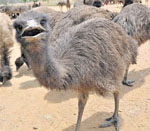|

With the blessings of the Government of India, emus, ostriches, ducks, quails and turkeys are bred with the aim of being killed for their body parts. Revealing double ethical standards, the emu Australia’s national bird is exploited, but not the peacock, India’s national bird.
Foremost, Beauty Without Cruelty feels that breeding and raising creatures for slaughter is unethical. It goes against the basic principle of ahinsa upon which
our country’s culture is based.
Despite which the fact is that thousands of
chickens are bred to be killed daily. The poultry industry has successfully
marketed flesh and eggs to the gullible thus turning many traditional vegetarians.
Emus and Ostriches
Emu farming has expanded out of Andhra Pradesh to other states like Maharashtra, Goa, Gujarat, Karnataka, Pondicherry, Kerala, Tamil Nadu, Orissa, Madhya Pradesh, Punjab, Uttar Pradesh, Haryana, West Bengal, Uttarkhand and Rajasthan. In 2012 it was estimated that there were 8,000 emu farmers in India but no official records to prove the claim.
Following the collapse of emu farming in Tamil Nadu, in 2012 BWC wrote to the Ministry of Environment & Forests suggesting an immediate directive be sent out to state governments to expose the hype surrounding these ventures, ensure that no more loans are given, urgently inform farmers to stop breeding and shut down emu farms. The Ministry of Agriculture could also be asked to help them in view of the fact that Newcastle Disease that affects emus worldwide results in entire flocks dropped dead but continues to spread to poultry.
Although emu meat has being introduced in different restaurants, luckily it is still seen as an oddity. Oil for use in cosmetics and medicines and emu hide is exported. Other body parts of the emu and ostrich ranging from feathers to toe-nails are also sold for converting into items ranging from dusters to jewellery.
In India ostrich farming has not turned out as popular as emu farming. Internationally, farming of ratites has never resulted in expected returns and the industry has been rife with monetary scams in a few countries. The sufferers have been emus, ostriches – and humans. The lure of easy money is irresistible and scant thought is given to the fact that the birds are bred to be killed.
For detailed information on Ratites please read
http://www.bwcindia.org/Web/Awareness/LearnAbout/Ratites.html
Turkeys
Turkey is another poultry bird (like the ostrich and the emu) which is not native to India but is imported and bred here.
Selectively bred for many generations to grow fast and get bigger than their ancestors in the wild, turkeys are traditionally eaten in the West on Thanksgiving and Christmas. In fact, any “sumptuous roasted fowl” (like duck, goose, guinea fowl or chicken) is prepared for the table.
The normal life span of domesticated turkeys is 10 years, but they are kept alive for only about 6 months by which time they gain the desired weight or enough flesh/meat. Turkey broilers are slaughtered between 12 and 27 weeks as soon as they can provide 5.5 to 7.5 kgs of meat. The demand is at Christmas and New Year and, to a lesser extent for Diwali and Thanksgiving.
For detailed information on Turkeys please read
http://www.bwcindia.org/Web/Awareness/LearnAbout/Turkeys.html
Ducks
Farming ducks is being unfortunately encouraged by the government just like breeding and killing of other animals and birds. Duck farming is mainly found in the eastern and southern states and is promoted by the Central Poultry Development Organisation (Southern Region).
A lame duck is considered a loser. And duck farming certainly makes the ducks losers because they are specially bred for their eggs and meat – and for shuttlecock feathers too. Ducks, drakes and ducklings are considered absolute commercial commodities, not living creatures. They are reared in cramped conditions with restrictions on food and water.
For detailed information on Ducks please read http://www.bwcindia.org/Web/Awareness/LearnAbout/Ducks.html
Quails
In 2011 the Ministry of Environment & Forests prohibited the farming of Japanese quails (Coturnix japonica) by listing them in Schedule IV of the Wildlife (Protection) Act, 1972 – no new licence for farming, or permission for expansion, would be granted. BWC appreciated the Ministry’s stand, but asked it to go a step further by declaring all quail farming illegal because quail meat was eaten in different parts of India, and farming them was a cover-up for poaching wild quail. BWC also wrote to NABARD to withdraw their scheme promoting quail farms under Animal Husbandry, Model Bankable Projects. The DGM replied that they “have noted the contents and taken suitable action on the matter”.
For detailed information on Quails please read http://www.bwcindia.org/Web/Awareness/LearnAbout/Quails.html
Unless the Government of India lays down a policy against the import and breeding of animals and birds for killing, such exploitation will crop up every now and then all over India. Let us therefore demand that the Government ban all breeding for killing beginning with ratites and include ducks, quails, turkeys and others.
|